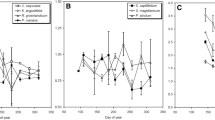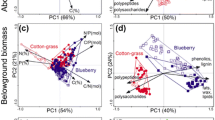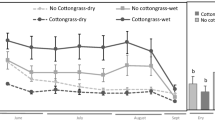Abstract
Plants are known to influence peatland carbon fluxes both i) directly through respiration and ii) by the production of litter and root exudates, which are then broken down by microbes within the peat matrix. In this study we investigated whether three different plant species typical of a UK blanket bog complex - Calluna vulgaris, Juncus effusus and mixed Sphagnum species - influence the carbon sequestering abilities of the peat that they grow in. To quantify this we measured fluxes of soil derived CO2 and CH4, and extractable levels of dissolved organic carbon (DOC) and phenolics, from peat samples taken from areas dominated by one of the three plant communities. It was found that there were significant differences between the carbon fluxes from the different sites, which we attributed to changes brought about by the vegetation on the pH, phenolic concentrations and extracellular enzyme activities found in the peat matrix. Peat taken from Sphagnum-dominated areas emitted less CO2 than the other two sample groups, and had lower overall DOC concentrations and phenol oxidase activities. Conversely, Juncus-peat had the highest CO2 and CH4 fluxes, along with the greatest phenol oxidase activities. Taking all the results into consideration the plants were ranked in order of their ability to reduce the loss of carbon from the peat soil within which they were growing: Sphagnum > Calluna > Juncus. These results suggest that plant community structures could be altered in order to maximise a peatland’s ability to be used as a carbon store should they need to be managed as part of a carbon stewardship scheme or a geoengineering project – if this was to be the sole management interest in an area of peatland.







Similar content being viewed by others
References
Badri DV, Vivanco JM (2009) Regulation and function of root exudates. Plant, Cell and Environment 32(6):666–681
Bais HP, Weir TL, Perry LG, Gilroy S, Vivanco JM (2006) The role of root exudates in rhizosphere interations with plants and other organisms. Annual Review of Plant Biology 57:233–266
Bergman I, Svensson BH, Nilsson M (1998) Regulation of methane production in a Swedish acid mire by pH, temperature and substrate. Soil Biology & Biochemistry 30(6):729–741
Box JD (1983) Investigation of the Folin-Ciocalteau phenol reagent for the determination of polyphenolic substances in natural-waters. Water Research 17(5):511–525
Bragazza L, Freeman C, Jones T, Rydin H, Limpens J, Fenner N, Ellis T, Gerdol R, Hajek M, Hajek T, Lacumin P, Kutnar L, Tahvanainen T, Toberman H (2006) Atmospheric nitrogen deposition promotes carbon loss from peat bogs. Proceedings of the National Academy of Sciences of the United States of America 103(51):19386–19389
Bridgham SD, Richardson CJ (1992) Mechanisms on controlling soil respiration (CO2 and CH4) in southern peatlands. Soil Biology & Biochemistry 24(11):1089–1099
Bridgham SD, Cadillo-Quiroz H, Keller JK, Zhuang Q (2013) Methane emissions from wetlands: biogeochemical, microbial, and modeling perspectives from local to global scales. Global Change Biology 19:1325–1346
Chabbi A (1999) Juncus bulbosus as a pioneer species in acidic lignite mining lakes: interactions, mechanism and survival strategies. New Phytologist 144(1):133–142
Chapin FS, BretHarte MS, Hobbie SE, Zhong HL (1996) Plant functional types as predictors of transient reponses of arctic vegetation to global change. Journal of Wetland Science 7(3):347–358
Cheng WX (1999) Rhizosphere feedbacks in elevated CO2. Tree Physiology 19(4–5):313–320
Cheng WX, Johnson DW, Fu SL (2003) Rhizosphere effects on decomposition: controls of plant species, phenology, and fertilization. Soil Science Society of America Journal 67(5):1418–1427
Dorodnikov M, Knorr KH, Kuzyakov Y, Wilmking M (2011) Plant-mediated CH4 transport and contribution of photosynthates to methanogenesis at a boreal mire: a C-14 pulse-labeling study. Biogeosciences 8(8):2365–2375
Dowrick DJ, Freeman C, Lock MA, Reynolds B (2006) Sulphate reduction and the suppression of peatland methane emissions following summer drought. Geoderma 132(3–4):384–390
Dunfield P, Knowles R, Dumont R, Moore TR (1993) Methane production and consumption in temperate and sub-Arctic peat soils - response to temperature and pH. Soil Biology & Biochemistry 25(3):321–326
Dunn C, Freeman C (2011) Peatlands: our greatest source of carbon credits? Carbon Management 2(3):289–301
Dunn C, Jones TG, Girard A, Freeman C (2014) Methodologies for extracellular enzyme assays from wetland soils. Wetlands 34(1):9–17
Ervin GN, Wetzel RG (2000) Allelochemical autotoxicity in the emergent wetland macrophyte Juncus effusus (Juncaceae). American Journal of Botany 87(6):853–860
Evans CD, Monteith DT, Cooper DM (2005) Long-term increases in surface water dissolved organic carbon: observations, possible causes and environmental impacts. Environmental Pollution 137(1):55–71
Evans CD, Jones TG, Burden A, Ostle N, Zielinski P, Cooper MDA, Peacock M, Clark JM, Oulehle F, Cooper D, Freeman C (2012) Acidity controls on dissolved organic carbon mobility in organic soils. Global Change Biology 18(11):3317–3331
Fenner N, Freeman C, Lock MA, Harmens H, Reynolds B, Sparks T (2007a) Interactions between elevated CO2 and warming could amplify DOC exports from peatland catchments. Environmental Science & Technology 41(9):3146–3152
Fenner N, Ostle NJ, McNamara N, Sparks T, Harmens H, Reynolds B, Freeman C (2007b) Elevated CO2 effects on peatland plant community carbon dynamics and DOC production. Ecosystems 10(4):635–647
Freeman C, Hudson J, Lock MA, Reynolds B, Swanson C (1994) A possible role of sulfate in the supression of wetland methane fluxes following drought. Soil Biology & Biochemistry 26(10):1439–1442
Freeman C, Liska G, Ostle NJ, Jones SE, Lock MA (1995) The use of fluorogenic substrates for measuring enzyme-activity in peatlands. Plant and Soil 175(1):147–152
Freeman C, Ostle N, Kang H (2001) An enzymic ‘latch’ on a global carbon store - A shortage of oxygen locks up carbon in peatlands by restraining a single enzyme. Nature 409(6817):149–149
Freeman C, Ostle NJ, Fenner N, Kang H (2004) A regulatory role for phenol oxidase during decomposition in peatlands. Soil Biology & Biochemistry 36(10):1663–1667
Freeman C, Fenner N, Shirsat AH (2012) Peatland geoengineering: an alternative approach to terrestrial carbon sequestration. Philosophical Transactions Series A, Mathematical, Physical, and Engineering Sciences 370(1974):4404–4421
Fridovich I (1998) Oxygen toxicity: a radical explanation. Journal of Experimental Biology 201(8):1203–1209
Frolking S, Roulet N, Fuglestvedt J (2006) How northern peatlands influence the Earth’s radiative budget: sustained methane emission versus sustained carbon sequestration. Journal of Geophysical Research-Biogeosciences 111(G1):10
Gauci V, Chapman SJ (2006) Simultaneous inhibition of CH4 efflux and stimulation of sulphate reduction in peat subject to simulated acid rain. Soil Biology & Biochemistry 38(12):3506–3510
Genney DR, Alexander IJ, Hartley SE (2000) Exclusion of grass roots from soil organic layers by Calluna: the role of ericoid mycorrhizas. Journal of Experimental Botany 51(347):1117–1125
Gray A, Levy PE, Cooper MDA, Jones T, Gaiawyn J, Leeson SR, Ward SE, Dinsmore KJ, Drewer J, Sheppard LJ, Ostle NJ, Evans CD, Burden A, Zielinski P (2013) Methane indicator values for peatlands: a comparison of species and functional groups. Global Change Biology 19(4):1141–1150
Green SM, Baird AJ, Boardman CP, Gauci V (2014) A mesocosm study of the effect of restoration on methane (CH4) emissions from blanket peat. Wetlands Ecology and Management 22(5):523–537
Hansell DA, Kadko D, Bates NR (2004) Degradation of terrigenous dissolved organic carbon in the western Arctic Ocean. Science 304(5672):858–861
Hanson RS, Hanson TE (1996) Methanotrophic bacteria. Microbiological Reviews 60(2):439
Henneberg A, Sorrell BK, Brix H (2012) Internal methane transport through Juncus effusus: experimental manipulation of morphological barriers to test above- and below-ground diffusion limitation. New Phytologist 196(3):799–806
Huang Y, Stankiewicz BA, Eglinton G, Snape CE, Evans B, Latter PM, Ineson P (1998) Monitoring Biomacromolecular degradation of Calluna vulgaris in a 23 year field experiment using solid state 13C-NMR and pyrolysis-GC/MS. Soil Biology and Biochemistry 30(12):1517–1528
Kayranli B, Scholz M, Mustafa A, Hedmark A (2010) Carbon storage and fluxes within freshwater wetlands: a critical review. Wetlands 30(1):111–124
Kuehn KA, Lemke MJ, Suberkropp K, Wetzel RG (2000) Microbial biomass and production associated with decaying leaf litter of the emergent macrophyte Juncus effusus. Limnology and Oceanography 45(4):862–870
Kuiper JJ, Mooij WM, Bragazza L, Robroek BJ (2014) Plant functional types define magnitude of drought response in peatland CO2 exchange. Ecology 95(1):123–131
Kuzyakov Y (2002) Review: factors affecting rhizosphere priming effects. Journal of Plant Nutrition and Soil Science-Zeitschrift Fur Pflanzenernahrung Und Bodenkunde 165(4):382–396
Laanbroek HJ (2010) Methane emission from natural wetlands: interplay between emergent macrophytes and soil microbial processes. A mini-review. Annals of Botany 105(1):141–153
Lai DYF (2009) Methane dynamics in northern peatlands: a review. Pedosphere 19(4):409–421
Levy PE, Gray A, Leeson SR, Gaiawyn J, Kelly MPC, Cooper MDA, Dinsmore KJ, Jones SK, Sheppard LJ (2011) Quantification of uncertainity in trace gas fluxes measured by the static chamber method. European Journal of Soil Science 62:811–821
Limpens J, Berendse F, Blodau C, Canadell JG, Freeman C, Holden J, Roulet N, Rydin H, Schaepman-Strub G (2008) Peatlands and the carbon cycle: from local processes to global implications - a synthesis. Biogeosciences 5(6):1475–1491
Moore TR, Bubier JL, Frolking SE, Lafleur PM, Roulet NT (2002) Plant biomass and production and CO2 exchange in an ombrotrophic bog. Journal of Ecology 90(1):25–36
Neff JC, Hooper DU (2002) Vegetation and climate controls on potential CO2, DOC and DON production in northern latitude soils. Global Change Biology 8(9):872–884
Pastor J, Solin J, Bridgham SD, Updegraff K, Harth C, Weishampel P, Dewey B (2003) Global warming and the export of dissolved organic carbon from boreal peatlands. Oikos 100(2):380–386
Pind A, Freeman C, Lock MA (1994) Enzymatic degradation of phenolic materials in peatlands - measurement of Phenol Oxidase activity. Plant and Soil 159(2):227–231
Rasmussen S, Wolff C, Rudolph H (1995) Compartmentalization of phenolic constituents in Sphagnum. Phytochemistry 38(1):35–39
Roura-Carol M, Freeman C (1999) Methane release from peat soils: effects of Sphagnum and Juncus. Soil Biology & Biochemistry 31(2):323–325
Royal Society (2009) Geoengineering the climate. Science, governance and uncertainty. The Royal Society, London
Schimel JP (1995) Plant-transport and methane production as controls on methane flux from arctic wet meadow tundra. Biogeochemistry 28(3):183–200
Shackle VJ, Freeman C, Reynolds B (2000) Carbon supply and the regulation of enzyme activity in constructed wetlands. Soil Biology & Biochemistry 32(13):1935–1940
Shannon RD, White JR, Lawson JE, Gilmour BS (1996) Methane efflux from emergent vegetation in peatlands. Journal of Ecology 84(2):239–246
Sorrell BK (1999) Effect of external oxygen demand on radial oxygen loss by Juncus roots in titanium citrate solutions. Plant, Cell and Environment 22(12):1587–1593
Strack M, Waddington JM, Bourbonniere RA, Buckton EL, Shaw K, Whittington P, Price JS (2008) Effect of water table drawdown on peatland dissolved organic carbon export and dynamics. Hydrological Processes 22(17):3373–3385
Strom L, Ekberg A, Mastepanov M, Christensen TR (2003) The effect of vascular plants on carbon turnover and methane emissions from a tundra wetland. Global Change Biology 9(8):1185–1192
Sutton-Grier AE, Megonigal JP (2011) Plant species traits regulate methane production in freshwater wetland soils. Soil Biology & Biochemistry 43(2):413–420
Tipping E, Woof C, Rigg E, Harrison AF, Ineson P, Taylor K, Benham D, Poskitt J, Rowland AP, Bol R, Harkness DD (1999) Climatic influences on the leaching of dissolved organic matter from upland UK Moorland soils, investigated by a field manipulation experiment. Environment International 25(1):83–95
Updegraff K, Bridgham SD, Pastor J, Weishampel P, Harth C (2001) Response of CO2 and CH4 emissions from peatlands to warming and water table manipulation. Ecological Applications 11(2):311–326
van der Heijden E, Boon JJ (1994) A combined pyrolysis mass spectrometric and light microscopic study of peatified Calluna wood isolated from raised bog peat deposits. Organic Geochemistry 22(6):903–919
Van Veen JA, Liljeroth E, Lekkerkerk LJA, Vandegeijn SC (1991) Carbon fluxes in plant-soil systems at elevated atmospheric CO2 levels. Ecological Applications 1(2):175–181
Ward SE, Bardgett RD, McNamara NP, Adamson JK, Ostle NJ (2007) Long-term consequences of grazing and burning on northern peatland carbon dynamics. Ecosystems 10(7):1069–1083
Ward SE, Bardgett RD, McNamara NP, Ostle NJ (2009) Plant functional group identity influences short-term peatland ecosystem carbon flux: evidence from a plant removal experiment. Functional Ecology 23(2):454–462
Ward SE, Ostle NJ, McNamara NP, Bardgett RD (2010) Litter evenness influences short-term peatland decomposition processes. Oecologia 164(2):511–520
Ward SE, Ostle NJ, Oakley S, Quirk H, Henrys PA, Bardgett RD (2013) Warming effects on greenhouse gas fluxes in peatlands are modulated by vegetation composition. Ecology Letters 16(10):1285–1293
Wetzel RG, Howe MJ (1999) High production in a herbaceous perennial plant achieved by continuous growth and synchronized population dynamics. Aquatic Botany 64(2):111–129
Wikum DA, Shanholtzer GF (1978) Application of Braun-Blanquet cover-abundance scale for vegetation analysis in land-development studies. Environmental Management 2(4):323–329
Williams CJ, Shingara EA, Yavitt JB (2000) Phenol oxidase activity in peatlands in New York State: response to summer drought and peat type. Wetlands 20(2):416–421
Worrall F, Evans MG, Bonn A, Reed MS, Chapman D, Holden J (2009) Can carbon offsetting pay for upland ecological restoration? Science of the Total Environment 408(1):26–36
Yan W, Artz RRE, Johnson D (2008) Species-specific effects of plants colonising cutover peatlands on patterns of carbon source utilisation by soil microorganisms. Soil Biology & Biochemistry 40(2):544–549
Zhai X, Piwpuan N, Arias CA, Headley T, Brix H (2013) Can root exudates from emergent wetland plants fuel denitrification in subsurface flow constructed wetland systems? Ecological Engineering 6:555–563
Acknowledgments
This research was funded by the Knowledge and Economy Skills Scholarship, which is part funded by the European Social Fund through the European Union’s Convergence programme and administered by the Welsh Assembly Government. We would also like to thank George Meyrick of Energy and Environment Business Services for supporting this research.
Author information
Authors and Affiliations
Corresponding author
Rights and permissions
About this article
Cite this article
Dunn, C., Jones, T.G., Roberts, S. et al. Plant Species Effects on the Carbon Storage Capabilities of a Blanket bog Complex. Wetlands 36, 47–58 (2016). https://doi.org/10.1007/s13157-015-0714-7
Received:
Accepted:
Published:
Issue Date:
DOI: https://doi.org/10.1007/s13157-015-0714-7




